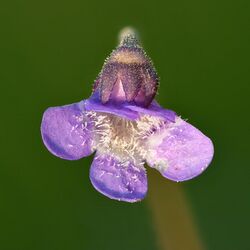Biology:Pinguicula vulgaris
| Pinguicula vulgaris | |
|---|---|

| |
| Scientific classification | |
| Kingdom: | Plantae |
| Clade: | Tracheophytes |
| Clade: | Angiosperms |
| Clade: | Eudicots |
| Clade: | Asterids |
| Order: | Lamiales |
| Family: | Lentibulariaceae |
| Genus: | Pinguicula |
| Species: | P. vulgaris
|
| Binomial name | |
| Pinguicula vulgaris | |
Pinguicula vulgaris, the common butterwort, is a perennial carnivorous plant in the bladderwort family, Lentibulariaceae.
Description
It grows to a height of 3–16 cm, and is topped with a purple, and occasionally white, flower that is 15 mm or longer, and shaped like a funnel. This butterwort grows in damp environments such as bogs and swamps, in low or subalpine elevations.[1] Being native to environments with cold winters, they produce a winter-resting bud (hibernaculum). There are three forms originating from Europe: P. vulgaris f. bicolor, which has petals that are white and purple; P. vulgaris f. albida, which has all white petals; and P. vulgaris f. alpicola, which has larger flowers.[2] The taxonomic status of these forms is not universally recognised - see e.g. The Plant List.[3]
Common butterwort is an insectivorous plant. Its leaves have glands that excrete a sticky fluid that traps insects to its leaves; its glands also produce digestive enzymes that work to consume the insects externally.[4] This serves as a way for the plant to access a source of nitrogen, as they generally grow in soil that is acidic and low in nutrients, such as bogs.[4][5] Insect capture is an adaptation to nutrient-poor conditions, and the plant is highly dependent on insects for nitrogen.[6]
Distribution
It has a generally circumboreal distribution, being native to almost every country in Europe as well as Russia , Canada , and the United States .[5][7] It is generally found growing in places such as bogs, fens, alvars, and other areas with limestone bedrock and alkaline waters.[5]
Whole plant, Norway
References
- ↑ Plants of the Pacific Northwest. Lone Pine Publishing, 1994. p. 351
- ↑ The Savage Garden, Revised: Cultivating Carnivorous Plants. Random House LLC, 2013.
- ↑ "The Plant List (2013). Version 1.1.: Pinguicula vulgaris L.". London, U.K.: Royal Botanic Gardens, Kew and Missouri Botanic Garden. http://www.theplantlist.org/tpl1.1/record/kew-2537397. Retrieved 2 September 2016.
- ↑ 4.0 4.1 "Nature up close: The carnivorous Butterwort plant". June 14, 2018. https://www.cbsnews.com/news/nature-up-close-butterworts/.
- ↑ 5.0 5.1 5.2 "A Circumboreal Butterwort". December 30, 2015. https://www.indefenseofplants.com/blog/2015/12/30/a-circumboreal-butterwort.
- ↑ Karlsson, P. S.; Carlsson, B. (1984). "Why Does Pinguicula vulgaris L. Trap Insects?". The New Phytologist 97 (1): 25–30. doi:10.1111/j.1469-8137.1984.tb04105.x. http://www.jstor.org/stable/2434191.
- ↑ Anderberg, Arne. "Den Virtuella Floran, Pinguicula vulgaris L.". Naturhistoriska riksmuseet, Stockholm, Sweden. http://linnaeus.nrm.se/flora/di/lentibularia/pingu/pingvulv.jpg.
External links
Wikidata ☰ Q161658 entry
 |





